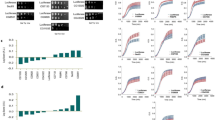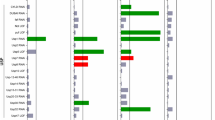Abstract
At least eight inherited human neurodegenerative diseases are caused by expansion of a polyglutamine domain within the respective proteins1,2. This confers dominant toxicity on the proteins, leading to dysfunction and loss of neurons. Expanded polyglutamine proteins form aggregates, including nuclear inclusions (NI), within neurons, possibly due to misfolding of the proteins3,4,5. NI are ubiquitinated and sequester molecular chaperone proteins and proteasome components6,7,8,9, suggesting that disease pathogenesis includes activation of cellular stress pathways to help refold, disaggregate or degrade the mutant disease proteins. Overexpression of specific chaperone proteins reduces polyglutamine aggregation in transfected cells7,8,9, but whether this alters toxicity is unknown. Using a Drosophila melanogaster model of polyglutamine disease10, we show that directed expression of the molecular chaperone HSP70 suppresses polyglutamine-induced neurodegeneration in vivo. Suppression by HSP70 occurred without a visible effect on NI formation, indicating that polyglutamine toxicity can be dissociated from formation of large aggregates. Our studies indicate that HSP70 or related molecular chaperones may provide a means of treating these and other neurodegenerative diseases associated with abnormal protein conformation and toxicity.
This is a preview of subscription content, access via your institution
Access options
Subscription info for Japanese customers
We have a dedicated website for our Japanese customers. Please go to natureasia.com to subscribe to this journal.
Buy this article
- Purchase on SpringerLink
- Instant access to full article PDF
Prices may be subject to local taxes which are calculated during checkout





Similar content being viewed by others
References
Paulson, H. Protein fate in neurodegenerative proteinopathies: polyglutamine diseases join the (mis)fold. Am. J. Hum. Genet. 64, 339–345 (1999).
Perutz, M. Glutamine repeats and neurodegenerative diseases: molecular aspects. Trends Biochem. Sci. 24, 58–63 (1999).
Davies, S.W. et al. Formation of neuronal intranuclear inclusions underlies the neurological dysfunction in mice transgenic for the HD mutation. Cell 90, 537–548 (1997).
DiFiglia, M. et al. Aggregation of huntingtin in neuronal intranuclear inclusions and dystrophic neurites in brain. Science 277, 1990–1993 (1997).
Paulson, H.L. et al. Intranuclear inclusions of expanded polyglutamine protein in spinocerebellar ataxia type 3. Neuron 19, 333–344 (1997).
Chai, Y., Koppenmhafer, S., Shoesmith, S., Perez, M. & Paulson, H. Evidence for proteasome involvement in polyglutamine disease: localization to nuclear inclusions in SCA3/MJD and suppression of polyglutamine aggregation in vitro. Hum. Mol. Genet. 8, 673–682 (1998).
Cummings, C.J. et al. Chaperone suppression of aggregation and altered subcellular proteasome localization imply protein misfolding in SCA1. Nature Genet. 19, 148–154 (1998).
Stenoien, D. et al. Polyglutamine-expanded androgen receptors form aggregates that sequester heat shock proteins, proteasome components and SRC-1, and are suppressed by the HDJ-2 chaperone. Hum. Mol. Genet. 8, 731–741 (1999).
Chai, Y., Koppenhafer, S., Bonini, N. & Paulson, H. Analysis of the role of heat shock protein (Hsp) chaperones in polyglutamine disease. J. Neurosci. (in press).
Warrick, J.M. et al. Expanded polyglutamine protein forms nuclear inclusions and causes neural degeneration in Drosophila. Cell 93, 939–949 (1998).
Ranum, L. et al. Spinocerebellar ataxia type 1 and Machado-Joseph disease: incidence of CAG expansions among adult-onset ataxia patients from 311 families with dominant, recessive, or sporadic ataxia. Am. J. Hum. Genet. 57, 603–603 (1995).
Schols, L. et al. Trinucleotide expansion within the MJD1 gene presents clinically as spinocerebellar ataxia and occurs most frequently in German SCA patients. Hum. Mol. Genet. 4, 1001–1005 (1995).
Durr, A. et al. Spinocerebellar ataxia 3 and Machado-Joseph disease: clinical, molecular and neuropathologic features. Ann. Neurol. 39, 490–491 (1996).
Ikeda, H. et al. Expanded polyglutamine in the Machado-Joseph disease protein induces cell death in vitro and in vivo. Nature Genet. 13, 196–202 (1996).
Brand, A.H. & Perrimon, N. Targeted gene expression as a means of altering cell fates and generating dominant phenotypes. Development 118, 401–415 (1993).
Wolff, T. & Ready, D.F. in The Development of Drosophila melanogaster (eds Bate, M. & Martinez-Arias, A.) 1277–1325 (Cold Spring Harbor Laboratory Press, Cold Spring Harbor, New York, 1993).
Hartl, F. Molecular chaperones in cellular protein folding. Nature 381, 571–580 (1996).
Hunt, C. & Morimoto, R. Conserved features of eukaryotic hsp70 genes revealed by comparison with the nucleotide sequence of human hsp70. Proc. Natl Acad. Sci. USA 82, 6455–6459 (1985).
Lin, D.M. & Goodman, C.S. Ectopic and increased expression of fasciclin II alters motoneuron growth cone guidance. Neuron 13, 507–523 (1994).
Klement, I. et al. Ataxin-1 nuclear localization and aggregation: role in polyglutamine-mediated disease in SCA1 transgenic mice. Cell 95, 41–53 (1998).
Saudou, F., Finkbeiner, S., Devys, D. & Greenberg, M. Huntingtin acts in the nucleus to induce apoptosis but death does not correlate with the formation of intranuclear inclusions. Cell 95, 55–66 (1998).
Elefant, F. & Palter, K. Tissue-specific expression of dominant negative mutant Drosophila HSC70 causes developmental defects and lethality. Mol. Biol. Cell 10, 2101–2117 (1999).
DebBurman, S., Raymond, G., Caughey, B. & Lindquist, S. Chaperone-supervised conversion of prion protein to its protease-resistant form. Proc. Natl Acad. Sci. USA 94, 13938–13943 (1997).
Glover, J. & Lindquist, S. Hsp104, Hsp70, and Hsp40: a novel chaperone system that rescues previously aggregated proteins. Cell 94, 73–82 (1998).
Jackson, G. et al. Polyglutamine-expanded human Huntingtin transgenes induce degeneration of Drosophila photoreceptor neurons. Neuron 21, 633–642 (1998).
Landsbury, P. Jr Structural neurobiology: are seeds at the root of neuronal degeneration? Neuron 19, 1151–1154 (1997).
Prusiner, S. Prion diseases and the BSE crisis. Science 278, 245–251 (1997).
Selkoe, D. Alzheimer's disease: genotypes, phenotypes, and treatments. Science 275, 630–631 (1997).
Polymeropoulos, M. et al. Mutation in the α-synuclein gene identified in families with Parkinson's disease. Science 276, 2045–2047 (1997).
Rubin, G.M. & Spradling, A.C. Genetic transformation of Drosophila with transposable element vectors. Science 218, 348–353 (1982).
Acknowledgements
We thank A. Cashmore and L. Lillien for critical reading of the manuscript. This research was funded in part by grants from the R.J. Carver Charitable Trust, faculty start-up funding from the University of Iowa Howard Hughes Medical Institute Resources Program (H.L.P.), the Wills Foundation (J.M.W.), the Wellcome Trust (H.Y.E.C.), the HDSA Coalition for the Cure, Hereditary Disease Foundation, Alzheimer's Foundation and the David and Lucile Packard Foundation (N.M.B.).
Author information
Authors and Affiliations
Corresponding author
Rights and permissions
About this article
Cite this article
Warrick, J., Chan, H., Gray-Board, G. et al. Suppression of polyglutamine-mediated neurodegeneration in Drosophila by the molecular chaperone HSP70. Nat Genet 23, 425–428 (1999). https://doi.org/10.1038/70532
Received:
Accepted:
Issue Date:
DOI: https://doi.org/10.1038/70532
This article is cited by
-
Modifier pathways in polyglutamine (PolyQ) diseases: from genetic screens to drug targets
Cellular and Molecular Life Sciences (2022)
-
Molecular and cellular pathways contributing to brain aging
Behavioral and Brain Functions (2021)
-
Glial AP1 is activated with aging and accelerated by traumatic brain injury
Nature Aging (2021)
-
Mutant Ataxin-3–Containing Aggregates (MATAGGs) in Spinocerebellar Ataxia Type 3: Dynamics of the Disorder
Molecular Neurobiology (2021)
-
Proteostasis-associated aging: lessons from a Drosophila model
Genes & Genomics (2021)



